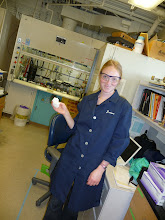Did you ever wonder why there was an unusual smell in the air during or after a lightning storm?
Well wonder no more: that smell is ozone, O3.
Ozone in the atmosphere is produced by the reaction of ultraviolet light from the sun with oxygen, O2. The ultraviolet radiation causes molecular oxygen to split into two oxygen atoms, each of which then combines with molecular oxygen to produce ozone.

Although the highest concentrations of ozone are found in the stratosphere, low concentrations of ozone are also present in the troposphere, where it is considered a pollutant. The "ozone layer" in the stratosphere acts as a greenhouse gas by absorbing and emitting some of the infrared radiation (heat) emitted by the Earth. Greenhouse gases are useful in moderating the temperature of the Earth, but when their concentrations change significantly due to human activity, the threat of "global warming" arises. Some other common greenhouse gases include water vapor, carbon dioxide, methane, nitrous oxide, and chlorofluorocarbons (CFCs).
Well wonder no more: that smell is ozone, O3.
Ozone in the atmosphere is produced by the reaction of ultraviolet light from the sun with oxygen, O2. The ultraviolet radiation causes molecular oxygen to split into two oxygen atoms, each of which then combines with molecular oxygen to produce ozone.

Although the highest concentrations of ozone are found in the stratosphere, low concentrations of ozone are also present in the troposphere, where it is considered a pollutant. The "ozone layer" in the stratosphere acts as a greenhouse gas by absorbing and emitting some of the infrared radiation (heat) emitted by the Earth. Greenhouse gases are useful in moderating the temperature of the Earth, but when their concentrations change significantly due to human activity, the threat of "global warming" arises. Some other common greenhouse gases include water vapor, carbon dioxide, methane, nitrous oxide, and chlorofluorocarbons (CFCs).





2 comments:
If we cannot slow the CFC production in the largest countries in the world, i.e China and India, perhaps we will all burn up from the global warming? What would you propose as alternative chemical solution for them to CFCs which would be as cheap and as affordable for them?
Global warming is unlikely to escalate to the point of burning up the Earth during our lifetimes, but there is certainly reason for concern, especially with regard to the areas of the world where pollution is the most severe. Several alternatives to CFC's are available and affordable in comparison, including hydrochlorofluorocarbons and hydrofluorocarbons. These compounds are slightly less effective at depleting the ozone layer than their non-hydrogenated counterparts.
Post a Comment